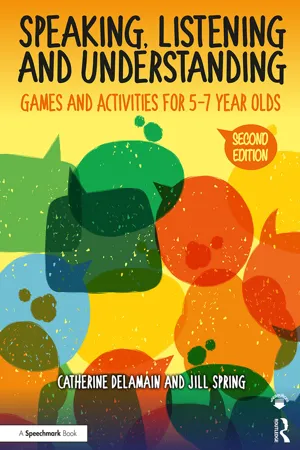
Speaking, Listening and Understanding
Games and Activities for 5-7 year olds
- 302 pages
- English
- ePUB (mobile friendly)
- Available on iOS & Android
Speaking, Listening and Understanding
Games and Activities for 5-7 year olds
About this book
Speaking, Listening and Understanding is a practical resource packed full of games to improve young children's communication skills. The second edition of this bestselling resource contains a programme of games and activities to foster the speaking, listening and understanding skills of children aged from 5 to 7 years. The book seeks to address language and communication difficulties for primary-aged children by providing a range of fun and engaging activities. Suitable for whole classes or small groups of children, the activities focus on both understanding and using language in areas such as following instructions, thinking skills, inference, describing, narrating and playing with words.
Features include:
160 games and activities which are differentiated by stages and levels of ability;
A clear aim, equipment list and instructions for each activity;
Photocopiable templates for ease of use;
Supplementary resource sheets including pictures and scripts to use with the activities.
Now fully revised and updated in line with current policy and legislation, this book is suitable for young children in any school setting. It also includes material that may be used as an effective part of a speech and language therapy programme in consultation with a therapist. This is a unique manual that will be an essential addition to the materials used by professionals working with young children.
Frequently asked questions
- Essential is ideal for learners and professionals who enjoy exploring a wide range of subjects. Access the Essential Library with 800,000+ trusted titles and best-sellers across business, personal growth, and the humanities. Includes unlimited reading time and Standard Read Aloud voice.
- Complete: Perfect for advanced learners and researchers needing full, unrestricted access. Unlock 1.4M+ books across hundreds of subjects, including academic and specialized titles. The Complete Plan also includes advanced features like Premium Read Aloud and Research Assistant.
Please note we cannot support devices running on iOS 13 and Android 7 or earlier. Learn more about using the app.
Information
Understanding Spoken Language
Following Instructions
| Stage I | Stage III |
| Making Statues | Puppet Show |
| Hoops and Beanbags | Round Up |
| Musical Beanbags | Dotty |
| Jewellery Shop | Chicken Food |
| Stage II | Stage IV |
| Curtain Up! | Holiday Snaps |
| Find It | Talkative Teacher |
| Witch’s Brew | Amazing Mazes |
| Magic Cauldron | Letter Strings |
Stage I
Making Statues
Aim
Equipment
How to play
Examples
Tip
Extension
Hoops and Beanbags
Aim
Equipment
How to play
Examples
Examples
Musical Beanbags
Aim
Equipment
How to play
Examples
Tip
Jewellery Shop
Aim
Equipment
How to play
Tip
Stage II
Curtain Up!
Aim
Equipment
How to play
Examples
Find It
Aim
Equipment
Preparation
How to play
Table of contents
- Cover
- Title
- Copyright
- Contents
- Acknowledgements
- Preface
- Introduction
- How to use this Book
- 1 UNDERSTANDING SPOKEN LANGUAGE
- 2 USING SPOKEN LANGUAGE
- 3 TEACHING RESOURCES
- Bibliography